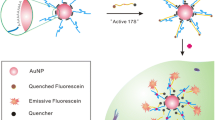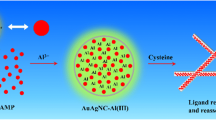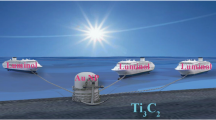Abstract
Copper nanomaterials based on DNA scaffold (DNA-Cu NMs) are becoming a novel fluorescent material, but it is still challenging to obtain highly fluorescent DNA-Cu NMs with excellent stability. In this work, we report a kind of copper nano-assemblies (Cu NASs) with aggregation-induced emission enhancement (AIEE) property using DNA dendrimers with sticky end as template. The sticky end of the DNA dendrimers induced the formation of much bigger Cu NASs with average size ranging from 131 to 264 nm, depending on the length of the DNA dendrimer sticky end from 6 bases to 27 bases. Compared with complete complementary DNA dendrimer, nearly 6-fold fluorescence enhancement was achieved using DNA dendrimer with 27 bases sticky end. Moreover, the DNA dendrimer-Cu NASs demonstrated excellent stability in serum and could be rapidly quenched by Pb2+ ions. Based on the above property, highly sensitive and selective fluorescent detection of Pb2+ ions was possible with a linear range of 2.0–100 nM and a detection limit of 0.75 nM. Due to the sensitive and rapid response to Pb2+ as well as excellent stability in complex matrix, the proposed fluorescent Cu NASs demonstrated high potential as an excellent fluorescent probe for Pb2+ in complex matrix.
Graphical abstract








Similar content being viewed by others
References
Truttmann V, Herzig C, Illes I, Limbeck A, Pittenauer E, Stoger-Pollach M, Allmaier G, Burgi T, Barrabes N, Rupprechter G (2020) Ligand engineering of immobilized nanoclusters on surfaces: ligand exchange reactions with supported Au11(PPh3)7Br3. Nanoscale 12:12809–12816. https://doi.org/10.1039/c9nr10353h
Agans RT, Dymond CE, Jimenez RE, Bunce NJ, Perry KJ, Salisbury RL, Hussain SM, Gupta RK, Karna SP (2020) Human nontumorigenic microglia synthesize strongly fluorescent Au/Fe nanoclusters, retaining bioavailability. ACS Omega 5:20983–20990. https://doi.org/10.1021/acsomega.0c02455
Baghdasaryan A, Besnard C, Lawson Daku LM, Delgado T, Burgi T (2020) Thiolato Protected copper sulfide cluster with the tentative composition Cu74S15(2-PET)45. Inorg Chem 59:2200–2208. https://doi.org/10.1021/acs.inorgchem.9b02828
Deng HH, Shi XQ, Wang FF, Peng HP, Liu AL, Xia XH, Chen W (2017) Fabrication of water-soluble, green-emitting gold nanoclusters with a 65% photoluminescence quantum yield via host-guest recognition. Chem Mater 29:1362–1369. https://doi.org/10.1021/acs.chemmater.6b05141
Maity S, Bain D, Patra A (2019) Engineering atomically precise copper nanoclusters with aggregation induced emission. J Phys Chem C 123:2506–2515. https://doi.org/10.1021/acs.jpcc.8b09467
Gu Y, Zhao Z, Su H, Zhang P, Liu J, Niu G, Li S, Wang Z, Kwok RTK, Ni XL, Sun J, Qin A, Lam JWY, Tang BZ (2018) Exploration of biocompatible AIEgens from natural resources. Chem Sci 9:6497–6502. https://doi.org/10.1039/c8sc01635f
Zhou T, Zhu J, Gong L, Nong L, Liu J (2019) Amphiphilic block copolymer-guided in situ fabrication of stable and highly controlled luminescent copper nanoassemblies. J Am Chem Soc 141:2852–2856. https://doi.org/10.1021/jacs.8b12026
Li J, Hu X, Zhou Y, Zhang L, Ge Z, Wang X, Xu W (2019) β-Cyclodextrin-stabilized Au nanoparticles for the detection of butyl benzyl phthalate. ACS Appl Nano Mater 2:2743–2751. https://doi.org/10.1021/acsanm.9b00258
You JG, Tseng WL (2019) Peptide-induced aggregation of glutathione-capped gold nanoclusters: a new strategy for designing aggregation-induced enhanced emission probes. Anal Chim Acta 1078:101–111. https://doi.org/10.1016/j.aca.2019.05.069
Guo Y, Tong X, Ji L, Wang Z, Wang H, Hu J, Pei R (2015) Visual detection of Ca2+ based on aggregation-induced emission of Au(I)-Cys complexes with superb selectivity. Chem Commun 51:596–598. https://doi.org/10.1039/c4cc07592g
Su X, Liu J (2017) pH-guided self-assembly of copper nanoclusters with aggregation-induced emission. ACS Appl Mater Interfaces 9:3902–3910. https://doi.org/10.1021/acsami.6b13914
Qing T, Zhang K, Qing Z, Wang X, Long C, Zhang P, Hu H, Feng B (2019) Recent progress in copper nanocluster-based fluorescent probing: a review, Microchim. Acta 186. https://doi.org/10.1007/s00604-019-3747-4
Liu R, Wang CQ, Hu JY, Su YY, Lv Y (2018) DNA-templated copper nanoparticles: versatile platform for label-free bioassays. Trends Anal Chem 105:436–452. https://doi.org/10.1016/j.trac.2018.06.003
Wang HB, Zhang HD, Chen Y, Huang KJ, Liu YM (2015) A label-free and ultrasensitive fluorescent sensor for dopamine detection based on double-stranded DNA templated copper nanoparticles. Sensors Actuators B Chem 220:146–153. https://doi.org/10.1016/j.snb.2015.05.055
Cao Q, Li J, Wang EK (2019) Recent advances in the synthesis and application of copper nanomaterials based on various DNA scaffolds. Biosens Bioelectron 132:333–342. https://doi.org/10.1016/j.bios.2019.01.046
Kim S, Kim JH, Kwon WY, Hwang SH, Cha BS, Kim JM, Oh SS, Park KS (2019) Synthesis of DNA-templated copper nanoparticles with enhanced fluorescence stability for cellular imaging. Microchim Acta 186:5. https://doi.org/10.1007/s00604-019-3620-5
Ran X, Wang ZZ, Pu F, Ju EG, Ren JS, Qu XG (2021) Nucleic acid-driven aggregation-induced emission of Au nanoclusters for visualizing telomerase activity in living cells and in vivo dagger. Materials Horizons 7:1769–1775. https://doi.org/10.1039/d0mh01875a
Ouyang X, Wang M, Guo L, Cui C, Liu T, Ren Y, Zhao Y, Ge Z, Guo X, Xie G, Li J, Fan C, Wang L (2020) DNA nanoribbon-templated self-assembly of ultrasmall fluorescent copper nanoclusters with enhanced luminescence, Angew. Chem, Int Ed Engl 59:11836–11844. https://doi.org/10.1002/anie.202003905
Meng HM, Zhang X, Lv Y, Zhao Z, Wang NN, Fu T, Fan H, Liang H, Qiu L, Zhu G, Tan W (2014) DNA dendrimer: an efficient nanocarrier of functional nucleic acids for intracellular molecular sensing. ACS Nano 8:6171–6181. https://doi.org/10.1021/nn5015962
Chen J, Liu J, Fang Z, Zeng L (2012) Random dsDNA-templated formation of copper nanoparticles as novel fluorescence probes for label-free lead ions detection. Chem Commun 48:1057–1059. https://doi.org/10.1039/c2cc16668b
Wang JX, Li J, Li Y, Zhang ZJ, Wang L, Wang D, Su L, Zhang XJ, Tang BZ (2020) pH-responsive Au(I)-disulfide nanoparticles with tunable aggregation-induced emission for monitoring intragastric acidity. Chem Sci 11:6472–6478. https://doi.org/10.1039/d0sc01843k
Li Q, Mosquera MA, Jones LO, Parakh A, Chai JS, Jin RC, Schatz GC, Gu XW (2020) Pressure-induced optical transitions in metal nanoclusters. ACS Nano 14:11888–11896. https://doi.org/10.1021/acsnano.0c04813
Li H, Rothberg L (2004) Colorimetric detection of DNA sequences based on electrostatic interactions with unmodified gold nanoparticles. Proc Natl Acad Sci U S A 101:14036–14039. https://doi.org/10.1073/pnas.0406115101
Li J, Fu W, Bao J, Wang Z, Dai Z (2018) Fluorescence regulation of copper nanoclusters via DNA template manipulation toward design of a high signal-to-noise ratio biosensor. ACS Appl Mater Interfaces 10:6965–6971. https://doi.org/10.1021/acsami.7b19055
Rajamanikandan R, Ilanchelian M (2018) Protein-protected red emittive copper nanoclusters as a fluorometric probe for highly sensitive biosensing of creatinine. Anal Methods 10:3666–3674. https://doi.org/10.1039/c8ay00827b
Wu Z, Liu J, Gao Y, Liu H, Li T, Zou H, Wang Z, Zhang K, Wang Y, Zhang H, Yang B (2015) Assembly-induced enhancement of Cu nanoclusters luminescence with mechanochromic property. J Am Chem Soc 137:12906–12913. https://doi.org/10.1021/jacs.5b06550
Wang WX, Wu Y, Li HW (2017) Regulation on the aggregation-induced emission (AIE) of DNA-templated silver nanoclusters by BSA and its hydrolysates. J Colloid Interface Sci 505:577–584. https://doi.org/10.1016/j.jcis.2017.06.033
Liu Y, Yao D, Zhang H (2018) Self-assembly driven aggregation-induced emission of copper nanoclusters: a novel technology for lighting. ACS Appl Mater Interfaces 10:12071–12080. https://doi.org/10.1021/acsami.7b13940
Nsibande SA, Forbes PBC (2019) Development of a quantum dot molecularly imprinted polymer sensor for fluorescence detection of atrazine. Luminescence 34:480–488. https://doi.org/10.1002/bio.3620
Hu X, Liu X, Zhang X, Chai H, Huang Y (2018) One-pot synthesis of the CuNCs/ZIF-8 nanocomposites for sensitively detecting H2O2 and screening of oxidase activity. Biosens Bioelectron 105:65–70. https://doi.org/10.1016/j.bios.2018.01.019
Qu Y, Ju Y, Cortez-Jugo C, Lin Z, Li S, Zhou J, Ma Y, Glab A, Kent SJ, Cavalieri F, Caruso F (2020) Template-mediated assembly of DNA into microcapsules for immunological modulation. Small:e2002750. https://doi.org/10.1002/smll.202002750
Wei X, Tian T, Jia S, Zhu Z, Ma Y, Sun J, Lin Z, Yang CJ (2015) Target-responsive DNA hydrogel mediated “stop-flow” microfluidic paper-based analytic device for rapid, portable and visual detection of multiple targets. Anal Chem 87:4275–4282. https://doi.org/10.1021/acs.analchem.5b00532
Kim JH, Han SH, Chung BH (2011) Improving Pb2+ detection using DNAzyme-based fluorescence sensors by pairing fluorescence donors with gold nanoparticles. Biosens Bioelectron 26:2125–2129. https://doi.org/10.1016/j.bios.2010.09.018
Chen XL, Wang XF, Lu Z, Luo HB, Dong L, Ji Z, Xu FL, Huo DQ, Hou CJ (2020) Ultra-sensitive detection of Pb2+ based on DNAzymes coupling with multicycle strand displacement amplification (M-SDA) and nano-graphene oxide. Sensors Actuators B Chem 311:127898. https://doi.org/10.1016/j.snb.2020.127898
Ghosh R, Sahoo AK, Ghosh SS, Paul A, Chattopadhyay A (2014) Blue-emitting copper nanoclusters synthesized in the presence of lysozyme as candidates for cell labeling. ACS Appl Mater Interfaces 6:3822–3828. https://doi.org/10.1021/am500040t
Ye T, Peng Y, Yuan M, Cao H, Yu JS, Li Y, Xu F (2019) Target-induced in-situ formation of fluorescent DNA-templated copper nanoparticles by a catalytic hairpin assembly: application to the determination of DNA and thrombin. Microchim Acta 186:760. https://doi.org/10.1007/s00604-019-3927-2
Huang YQ, Yang LN, Wang YS, Xue JH, Chen SH (2018) Protamine-stabilized gold nanoclusters as a fluorescent nanoprobe for lead(II) via Pb(II)-Au(I) interaction. Microchim Acta 185:483. https://doi.org/10.1007/s00604-018-3019-8
Deng HH, Fang XY, Huang KY, He SB, Peng HP, Xia XH, Chen W (2019) Regulation of metal ion selectivity of fluorescent gold nanoclusters by metallophilic interactions. Anal Chim Acta 1088:116–122. https://doi.org/10.1016/j.aca.2019.08.047
Xie J, Zheng Y, Ying JY (2010) Highly selective and ultrasensitive detection of Hg2+ based on fluorescence quenching of Au nanoclusters by Hg2+-Au+ interactions. Chem Commun 46:961–963. https://doi.org/10.1039/b920748a
Xu W, Zhao A, Zuo F, Khan R, Hussain HMJ, Li J (2020) A highly sensitive DNAzyme-based SERS biosensor for quantitative detection of lead ions in human serum. Anal Bioanal Chem 412:4565–4574. https://doi.org/10.1007/s00216-020-02709-2
Acknowledgements
The authors would like to thank Professor Xiao-Fang Shen of Jiangnan University for his valuable comments and advice in the preparation this paper. The work was supported by the National Natural Science Foundation of China (31871879), the National Key Research and Development Program (2018YFC1604400), and the National Key Research and Development Program (2019YFC1605405).
Author information
Authors and Affiliations
Corresponding authors
Ethics declarations
Conflict of interest
The authors declare no competing interests.
Additional information
Publisher’s note
Springer Nature remains neutral with regard to jurisdictional claims in published maps and institutional affiliations.
Supplementary Information
ESM 1
(PDF 3791 kb)
Rights and permissions
About this article
Cite this article
Li, M., Cai, YN., Peng, CF. et al. DNA dendrimer–templated copper nanoparticles: self-assembly, aggregation-induced emission enhancement and sensing of lead ions. Microchim Acta 188, 346 (2021). https://doi.org/10.1007/s00604-021-04967-y
Received:
Accepted:
Published:
DOI: https://doi.org/10.1007/s00604-021-04967-y




